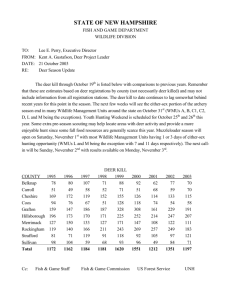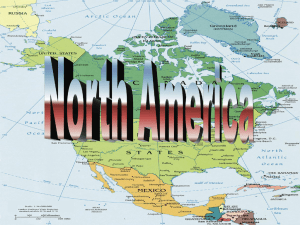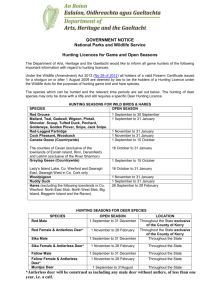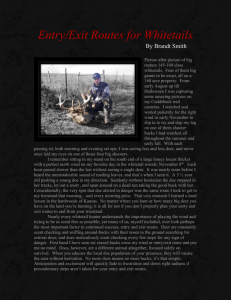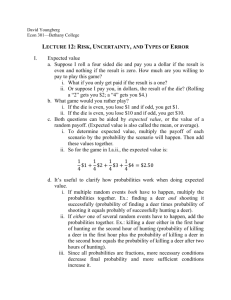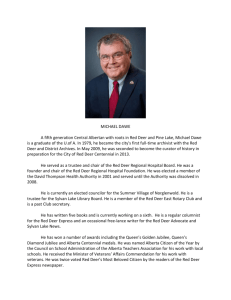Urban Bowhunting Specialist Program
advertisement
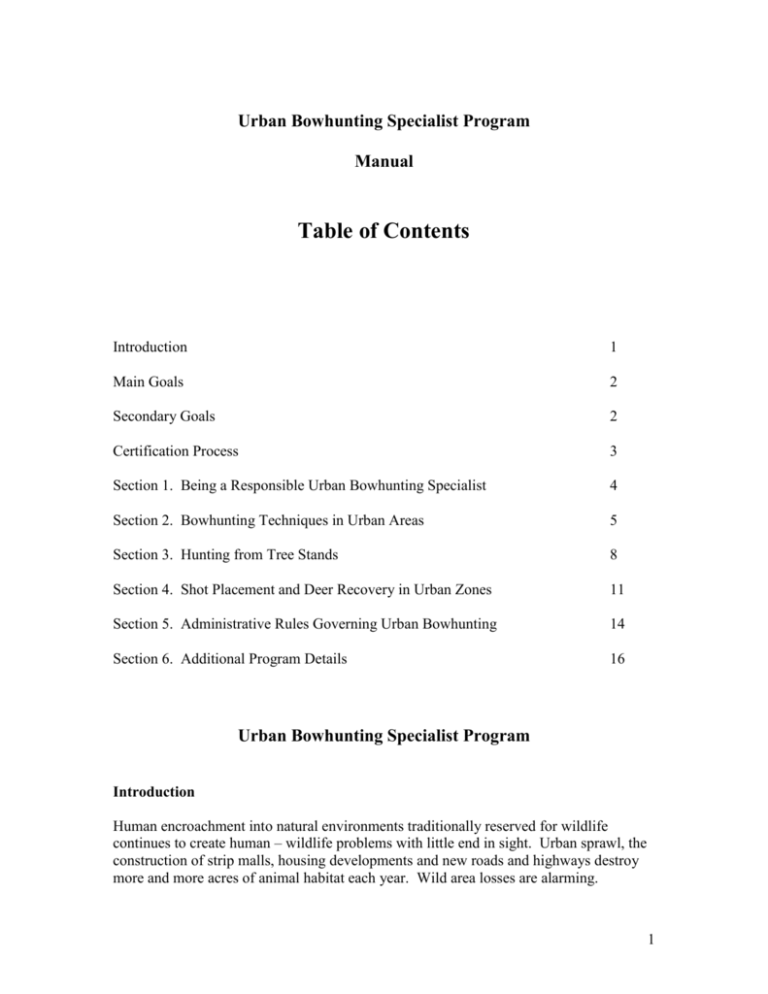
Urban Bowhunting Specialist Program Manual Table of Contents Introduction 1 Main Goals 2 Secondary Goals 2 Certification Process 3 Section 1. Being a Responsible Urban Bowhunting Specialist 4 Section 2. Bowhunting Techniques in Urban Areas 5 Section 3. Hunting from Tree Stands 8 Section 4. Shot Placement and Deer Recovery in Urban Zones 11 Section 5. Administrative Rules Governing Urban Bowhunting 14 Section 6. Additional Program Details 16 Urban Bowhunting Specialist Program Introduction Human encroachment into natural environments traditionally reserved for wildlife continues to create human – wildlife problems with little end in sight. Urban sprawl, the construction of strip malls, housing developments and new roads and highways destroy more and more acres of animal habitat each year. Wild area losses are alarming. 1 Missouri is not immune, therefore, from the many predicaments associated with urban wildlife that has been forced out or, in some cases, forced to “live with” their new, human neighbors. The adaptability of white-tailed deer to human encroachment into their space is surprising to many residents of new subdivisions. Deer not only accept their new human neighbors and all of their accoutrements but also have flourished in an environment never before believed possible. Deer feeding in backyards, flower gardens, parks, and playgrounds and along suburban byways are now a common occurrence. Any little thicket or woodlot holds resting whitetails during the day. Many new suburbanites don’t know how to address the backyard deer situation. They see deer, at first, as beautiful animals indicative of the wild and natural state of Missouri. They are correct in this assessment. But, as the number of deer increases the problems they cause increase, as well. Deer often consume expensive ornamental plants, vegetable gardens, flowers and shrubs, for example. Small trees are killed by antler rubs made by bucks. Deer/vehicle accidents begin to increase causing thousands of dollars of damage and raising the potential for serious injury to drivers and passengers. It doesn’t take long for suburbanites to identify deer as “a problem”. Left to breed and populate an urban area, white-tailed deer can quickly become a serious problem as many municipalities in America have found out the hard way. Since the discharge of firearms and other projectile-firing devices has been banned within most suburban communities for safety reasons and where dogs stay in pens or on leashes, deer populations will grow, unchecked. One breeding pair of deer could lead to 40 deer in seven years! Help is on the way! Many forward-looking city councils have come to accept the use of veteran bowhunters to maintain deer herds in their villages. Bowhunting has an impeccable record of safety, is very efficient and a proven method of killing big game and is quiet and unobtrusive – the perfect solution to urban deer problems. Urban Bowhunting Specialists (UBS) are specially certified bowhunters trained to remove deer from urban settings. The Missouri Bowhunting Council is looking for team players that will help manage the resource according to an exacting plan. Highly qualified, veteran bowhunters will teach seasoned bowhunters special techniques for removing problem deer from the close quarters of a heavily populated suburban area. Certified Urban Bowhunting Specialists will pledge to abide by the program’s rules and regulations in exchange for the satisfaction of having helped with deer population control. City managers, conservation officials and citizens in urban deer zones need our help. Learn our techniques of urban bowhunting and we’ll certify you, as a UBS, to participate with a private landowner, in limiting the harmful effects of having too many white-tailed deer as neighbors. 2 Main Goals The UBS program has established the following Main Goals: Train veteran bowhunters on the use of special bowhunting techniques for removing antlerless deer from urban environments. This is a “shoot does” program. Significantly reduce antlerless deer numbers in over populated areas. Increase access for certified Urban Bowhunting Specialists to hunt areas identified as over populated with deer, focusing on areas within the boundaries of municipalities where firearms discharge is prohibited. Educate city officials on the value of utilizing Urban Bowhunting Specialists for the management of deer numbers within municipal boundaries during archery season. Match participating landowners with UBS-certified bowhunters who will respect private property rights without compromise and will abide by program rules. Promote safe and free deer removal as a public service to local communities by creating and maintaining a database of Urban Bowhunting Specialists. Secondary Goals The UBS program has established the following Secondary Goals: Promote the UBS program on private lands identified to hold excessive numbers of deer and where firearm discharge is legal but where landowners do not allow hunting with firearms. Provide venison to the Share the Harvest program at little or no cost to the UBS. Provide deer hides, antlers, sinew, and etc. to Native American tribes for educational purposes. Increase the awareness of the benefits of bowhunter education. Certification Process After successfully completing the National Bowhunter Education Program (8 hours), the Missouri Bowhunting Council’s Urban Bowhunting Specialist program (4 hours), a Panel Review and any shooting proficiency test that might be required, bowhunters will be 3 Certified - Highly Qualified to bowhunt deer in an urban setting. Your certification packet will include the following: A Certificate of Approval from the Missouri Bowhunting Council that you have successfully completed all of the requirements of the Urban Bowhunting Specialist program. Copy of your Bowhunting Resume for landowners, municipal officials. Copy of your signed Ethics Pledge promising to adhere to all Missouri Department of Conservation rules and regulations and the Rules of Fair Chase. Copy of a Letter of Recommendation from the Missouri Bowhunting Council verifying that you’re a “Highly Qualified Urban Bowhunting Specialist”. A copy of a written agreement between the MBC and the participating landowner(s) giving you Permission to Hunt on their property under certain rules. An ID Card and Proof of Insurance. A Dashboard Placard and/or Parking Sticker for your vehicle to be used when it is parked near your assigned hunting location. Daily Log Sheets for the compilation of data that will be provide in an Annual Report to the landowner. Following the Certification Process, each bowhunter will confer with an MBC Official for hunting assignments and to schedule a meeting with landowners. Are You Still Interested in Becoming an Urban Bowhunting Specialist? If, after this short introduction to the program, you are still not fully convinced you want to complete the work necessary to become a certified UBS, consider these advantages: You will have exclusive access to bowhunt deer on private property. Your new hunting area will, very likely, be close to your home. You will have the satisfaction of helping to reduce burgeoning deer numbers. You will be an ambassador of good will, helping to improve the image of bowhunting. Your can help feed the hungry by donating deer taken to Share the Harvest. Your hunting activities will be covered by liability insurance. The Urban Bowhunting Specialist program is looking for a few dedicated, ethical, responsible, dependable, safe, law-abiding and proficient bowhunters to help with a 4 problem – too many urban deer. The program, of necessity, requires special training in landowner/hunter relations and close quarter hunting techniques. Are you up to it? Are you one of those special bowhunters we’re looking for? Section 1. Being a Responsible Urban Bowhunter Specialist Human encroachment into traditional wildlife habitat by urban sprawl and housing subdivisions has created problems with wild animals. Couple that with the ability of deer to adapt to their new neighbors and to multiply unchecked and really big problems like health concerns, property damage, ecological damage, and deer/vehicle accidents occur. New management controls are needed. Bowhunting can help. Experience has shown us that the bowhunting option for removal of urban deer is more effective than trapping and relocating deer, birth control of deer, special fencing, deer repellents, firearms hunting and using sharpshooters. These other methods have been found to be impractical, prohibitively expensive, widely unacceptable and limited in application. Bowhunting is the key to success. Bowhunting is a safe and efficient method of managing the growing numbers of urban deer. Additional education is needed, however. This course will train veteran bowhunters to adapt their standard deer hunting methodologies to include special techniques better designed for use in urban zones. The long-term survival of the Urban Bowhunting Specialist program, however, depends upon each certified member of this special unit acting responsibly. Always hunt as if you are being watched. Your actions will speak for all bowhunters in the program, so please make sure you abide by UBS rules and state/municipal regulations. An Urban Bowhunting Specialist must play by the rules and must always maintain the highest level of conduct while hunting. He/she must show respect for private landowners and their property. The UBS must maintain impeccable landowner relations if the program is to work. Remember, gaining access to property is what this program is all about. Have a good plan for opening gates and stick to it. Your Responsibility as a UBS Always put your best foot forward in appearance and conduct, and always be considerate of others. Never drink alcohol or use drugs before or while hunting. Make sure no other bowhunter already has permission to hunt the property. 5 Respect landowners and their land. Talk to landowners and ask them what their concerns are about allowing you, a hunter, on their land. Are they concerned about the deer, your bow and arrows being safe, parking problems, neighborhood relations. Leave gates as you found them – open or closed. Find out where the landowner wants you to park your vehicle, exactly where you may hunt, and if he has any special rules. Ask if you may prune vegetation for shooting lanes, if you may use trail markers and any other requirement you may have. Once you’ve scouted the property and have located the tree you want to use for your stand, tell the landowner and ask if the location meets with his approval. Work out a hunting schedule with the landowner. Are morning hunts O.K.? How about hunting on weekends? Know state, county and city hunting regulations and abide by them. Check at city hall for ordinances that regulate hunting. Look for insurance requirements, tree stand location rules, application requirements, reports of success to city hall, etc. Know if the municipality you want to hunt has rules governing anti-solicitation and how best you can work with such rules. Before hunting, know where you can take a safe shot and where you may not. Consider that an arrow could ricochet over a hill or down a hollow; plan only safe shots. Take only responsible, 100% sure shots at deer that are relaxed and not on alert. Don’t shoot unless you’re certain that your arrow will strike the vitals and produce a quick kill. Be discreet in how you remove the harvested deer from the property. Special UBS rules may apply that limit field dressing or mandate covered-carcass removal. Retrieve all arrows and arrow parts shot at deer. Avoid confrontations with neighbors, others. A knowledge of conservation and the hunter’s role in urban deer management can be an important supporting element of any discussion, such, as the need to reduce antlerless deer numbers. Keep a low profile. You and bowhunting will be under the microscope when you’re hunting a neighborhood, so be as inconspicuous as possible. 6 A gate that you have worked hard to open to bowhunt is of no value to the program unless you hunt it and kill does. If you find that you will not be able to hunt a newly opened tract, pass it on to another UBS, with the permission of the landowner, of course. Bowhunters who chose to participate in the Urban Bowhunting Specialist program play a vital role in solving the problem of managing the ever-growing urban deer population. They must, however, maintain safe, ethical hunting practices and be fully responsible for their actions if they’re to be recognized as the best option for controlling urban deer. Section 2. Bowhunting Techniques in Urban Areas Bowhunting in heavily populated areas is much different than hunting in the countryside. Instead of having the luxury of hunting on hundreds of secluded acres, metro bowhunters may be limited to just a few acres in the middle of a heavily populated area. Access to a back lot may be across private lawns or down driveways, tree stand sites may be within a few hundred feet of activity areas in the landowner’s back yard and making killing shots are an absolute must. There is no margin for error. It goes without saying that your every step will be observed by the landowner, his family and by his neighbors. It’s “fishbowl” bowhunting. Urban Bowhunting Specialists, therefore, must take the utmost care to abide by the following rules and regulations to ensure that observed hunting activities are understood and accepted by the neighborhood. It only takes one mistake to bring our deer reduction program to a screeching halt. Rules of the Hunt For safety reasons, hunting from a tree stand elevated to at least 10 feet is required. The UBS program prohibits hunting from the ground. Some municipalities require that the hunter be higher than 10 feet so check your local ordinances. Local ordinances may limit a bowhunter’s common hunting techniques so check the rules carefully. Climbing stands are the preferred type because they do not damage trees. The UBS program requires that stands be removed from the property after each hunt to prevent children from playing with them and possibly being injured. The proper use of a certified tree stand safety harness is mandatory. Install your stand to provide shots that will be 20 yards distance or less. Shots taken must be 100% killing shots. Taking questionable shots is unacceptable and jeopardizes the entire program. 7 Know where you can take a safe shot and where you cannot. Only high downward angling shots are allowed for guaranteed arrow recovery. Shots must not be taken through brush that might produce a ricochet into populated areas. Retrieve all arrows shot, including broken parts, before leaving the hunting site. Razor sharp broadheads are mandatory. Set your bow up to shoot a heavy arrow. Shooting a heavy arrow will quiet the bow when shot, giving you the opportunity for multiple kills. Shoot only when an animal is relaxed and not alerted to danger. A relaxed deer, when hit with an arrow, will usually run away in the direction it’s headed when hit. Plan your shot with this tip in mind. Once the deer is struck, do not trail it until you’re sure it’s down for good. If you require help removing the carcass, make sure the landowner gives you permission for someone else to enter his land for such purposes. The same thing goes for using a two-wheeled cart for removal. It is your responsibility to ensure that no animal will travel very far after being hit. Do not trespass on neighboring land to retrieve a deer without permission. Make arrangements with your landowner’s neighbors before you begin your hunting activities for permission to initiate “retrieval trespass only”. The local conservation officer and/or police may be of assistance when retrieval trespass cannot be obtained. Deer hit or killed but not retrived must be reported to the municipality office, in most cases. Properly tag the deer immediately upon recovery. All evidence of the deer must be removed from the property. A plastic bag can be used for entrails or, better yet, field dress the deer at another permissible site. Be discreet when removing a deer from the landowner’s property. You may wish to cover the deer with a plastic tarp while it’s being removed. Most people don’t like seeing a dead animal so keep it out of sight as much as possible. You may wish to use an alternate, less conspicuous, route when removing a deer, with permission of the landowner, of course. Discuss it with him before your hunt. Stay on your assigned landowner’s property during the hunt and when accessing the hunting area. Do not take shortcuts across ground where you don’t have permission to trespass. 8 Use a flashlight while walking to and from your stand in low light to distinguish yourself from intruders. The casting of a light across the landscape to detect deer is illegal. Use your light to illuminate the pathway, only. Remain as inconspicuous as possible at all times. Don’t wear camo hats, caps or clothing while driving in the hunting neighborhood. When walking to and from your hunting area, don’t “show” yourself as a hunter so as to not alarm folks in the neighborhood. Keep your bow and arrows cased. Carry your camo clothing in a plain-colored pack to change into at a secluded spot or, better yet, simply dress-to-hunt in solid colored hunting pants and jacket. Don’t invite friends to hunt with you on private property without the landowner’s permission. The UBS insurance policy only covers bowhunters certified by the program. Avoid confrontations, no matter the circumstances. Missouri has a hunter harassment law that protects you while engaged in legal hunting pursuits but it’s best not to argue with an antagonist. You may wish to report harassment to local authorities if confrontations continue. Shoot does! The object of the UBS program is to help control deer numbers inside the city limits. Bowhunters can only accomplish this goal by shooting does and lots of them. You’re bowhunting permit allows the killing of bucks and you may be presented with the opportunity to take a nice one – go ahead. But remember, the program can only survive if you continue to hunt and kill does. Donations of venison to the Share the Harvest program are encouraged. Department of Conservation brochures will list participating Share the Harvest locker plants near you. Section 3. Hunting from Tree Stands Urban Bowhunting Specialists are veteran bowhunters and will have spent many hours hunting deer from an elevated tree stand. Tree stand hunting is, by far, the most effective and, therefore, the most popular technique for bowhunting deer. Due to safety considerations, the UBS program requires the use of tree stands set at a height of 10 feet or higher. Hunting from a treestand has many advantages and several disadvantages. Advantages Tree stands offer the hunter a large field of view. Incoming deer can be observed early, giving you time to set up for the shot. 9 The hunter is above the deer’s normal field of vision. Small, slow movements can go undetected when elevated stands are used, giving you the opportunity to move into position for the perfect shot. The down-wind flow of human scent is kept above the deer’s nose making it harder for the deer to detect the hunter by scent. Disadvantages Large, portable stands can be difficult to carry into the woods. Elevated posts offer little protection from the wind and cold. Estimating distances can be a challenge due to the optical illusion associated with downward angling shots. The vital area of a deer becomes smaller as the bowhunter’s height increases. Icy and wet climbing routes up a tree can increase the risk of falling. Tree stand hunting even under warm and dry conditions involves a degree of risk of injury resulting from falling. The Climbing Tree Stand The UBS program promotes the use of the Climbing Tree Stand. This type of stand allows the hunter to walk the stand up the tree while maintaining an attachment to the tree by a safety strap. It is the safest stand, in this regard, because the hunter is always connected to the tree by his safety equipment. Climbing Tree Stands, by their very nature, can be and should be removed from the tree following each hunt so that children playing in the woods at other times will not be tempted to play with the device and be injured. Climbing Tree Stands have their limitations. They should only be used on trees with straight, uniform trunks. Shaggy or slippery barked trees such as hickory or pine must be avoided and any tree that is wet or icy should not be chosen to climb. Always make sure the two sections of your climbing tree stand are secured together in some way so that the foot section can never fall to the ground leaving you stranded. Don’t climb with your gear pack or bow. Always use a haul rope to pull your gear and bow into the stand after you’re positively secured and, likewise, when you descend. Ladder Stands 10 Ladder Stands are becoming more popular because of their safe and convenient climbing route - a ladder. The UBS program permits ladder stands but only if they are removed following each hunt like a climbing stand and only if the landowner agrees that you may use one. Ladder stands, left in place following a hunt, will surely attract the attention of children playing in the woods resulting in the potential for an accident. Take them down and remove them after every hunt. Landowner Permission to Use Tree Stands It is the responsibility of the UBS to discuss your hunting method with the landowner. Again, if you prefer the option of using a ladder stand, discuss it with the landowner. You’ll want to assure the landowner that the stand you use will not damage the tree or present a danger to children. Make sure, as well, that the landowner understands that hunting from an elevated stand will not present a danger to you, either. Liability for an injury to anyone involved with the hunt must be minimized and the landowner should understand that you are going to do everything you can to prevent accidents. Safety Harness Use Falls from elevated tree stands happen. They often result in serious injury and can even cause death. Bowhunters accept a degree of risk when they climb up to a stand but that risk can and should be minimized by the use of safety equipment. The UBS program requires that their certified hunters utilize the very best protection against a fall available today – a full-body safety harness. Fall Protection Devices A Fall Protection Device is not acceptable. A Fall Protection Device is a strap or series of straps that a hunter wears in the tree stand that prevents him from reaching an edge that he could fall over to the ground. These devices are often made in the form of waist belts or chest-only harnesses. The small size of a tree stand platform, so small that it presents an edge within inches of a bowhunter’s feet, prohibits the use of a fall protection device as tree stand safety equipment. To be an effective fall protection device a waist belt or chest-only harness would have to cinch a bowhunter so close to the trunk of a tree that he couldn’t move into a shooting position. Used properly, a fall protection device would require that a bowhunter remain in either a standing or a sitting position. These limitations often result in a bowhunter using a fall protection device incorrectly, i.e. utilizing a long tether that could result in serious injury if a fall occurs. Fall Arrest Devices Bowhunters should wear only Fall Arrest Devices for safety. A Fall Arrest Device is a series of straps that are designed to safely and securely stop, or arrest, the fall of a bowhunter to the ground. Often called a Full Body Harness, this device catches the 11 falling bowhunter safely and suspends him close to the stand’s platform for an easy selfrescue. A full body harness utilizes a safety lanyard that attaches to the tree. The lanyard is just long enough to allow the bowhunter to move left and right in the stand, to stand and sit for shooting but is not too long that the force of an arrested fall could injure him. Besides, a full body harness is designed to catch a falling human safely and in an upright position. The UBS program requires that certified bowhunters wear protective fall arrest devices certified safe by the Tree Stand Manufacturer’s Association or OSHA while hunting. Stand Location in Urban Areas You will, of course, want to position your stand in a spot that will provide a close in, killing shot. Your experience as a bowhunter should make the decision easy. Hunting an urban area, however, presents several unique problems that will test your skills as a bowhunter. Once you’ve found that hot spot for your stand you will have to concern yourself with whether or not your elevated position will be out of sight of neighborhood residents. Hiding yourself from the neighbors prevents anxiety by those who may see you and wonder what’s going on. The police may be called to investigate. Trouble ensues. Practice sneak-in hunting when at all possible. Offer to show the landowner where you intend to place your stand. This could prevent any misunderstanding later. Adapt your stand location to keep as much timber and brush between you and the neighbors as possible. Position yourself on the backside of large trees, if possible. No matter how many neighbors have been notified about your hunting activities, some unknowing resident will spot you and call authorities. Do your homework and politely spread the word about your activities but only to local police and conservation officials. Keep a low profile and try not to advertise that you’re hunting. Section 4. Shot Placement and Deer Recovery in Urban Zones Shot placement and the route a deer takes out of the area after the arrow strikes home is an important concern for UBSs. You must apply all of your skill as a hunter, you must consider everything you’ve learned as a bowhunter to prevent the deer you’ve shot from dropping in someone’s backyard, front yard, the street or driveway! This point cannot be over emphasized. Here are some suggestions. 12 Make sure your bow, arrow and broadhead setup is absolutely silent when shot. From the first pull of the arrow across the arrow rest to the release of the string, your bow must shoot without making any noise. Any sudden noise will alert the deer and it will go into “escape mode” immediately. If, in addition, the arrow strike is felt by the animal, it may exit your safe zone at warp speed and, possibly, into someone else’s property before falling. Be patient. Wait for the animal to come close for a good shot. The deer you hit will likely run after being struck no matter how silent your equipment. Nevertheless, shooting a quiet bow will shorten the run. As an additional precaution against an arrow-struck deer running into someone’s yard, always wait until the deer is headed away from populated areas and is not alerted to danger before shooting. You must measure the demeanor and posture of the deer before you take the shot. A quiet deer will likely travel a shorter distance after the arrow strikes. Today’s fast bows and surgically sharp broadheads help send an arrow through a deer’s vitals without them even feeling the strike, many times. Always shoot very sharp broadheads and always wait for the 100% killing shot. Strive for producing a shot that will kill quickly and cleanly and one that can be delivered without making a sound. How an Arrow Works You’re an experienced bowhunter with many big game kills under your belt but it never hurts to review how your arrow works. It’s an effective device for producing a quick, humane death but only if used with the knowledge that accurate shot placement is essential. Accurate shot placement is the key to a quick kill and easy game recovery. Hunting arrows are tipped with razor sharp broadheads that are designed to cut lung tissues, to severe major arteries and veins and to produce a loss of blood and pressure in the chest cavity. The arrowhead, when shot through the chest cavity of a big game animal, initiates a cascade of physiological events that leads to unconsciousness and death. Most big game animals have anatomical features that are similar. All of them have two separate body cavities: the chest cavity and the abdominal cavity. The sheet-like diaphragm muscle separates the cavities. The diaphragm forms the rear of the chest cavity and the front of the abdominal cavity. It functions as the pump for the breathing process by producing a negative pressure in the chest cavity as it contracts that helps the lungs fill with air at each breath. As it relaxes, gases are exhaled from the lungs. The chest cavity is the bowhunter’s main target. It contains all the major organs and main vessels that sustain life. The heart and lungs dominate the chest cavity. Very large arteries and veins connect these two organs with each other and with the rest of the body. A broadhead-pointed arrow that passes through the chest cavity is certain to cut many of the vessels and organs, causing severe blood loss and organ dysfunction followed by death. 13 Your only target should be the chest cavity. The “double lung” shot describes the best hit a bowhunter can make – a hit that pushes the broadhead through both lungs, left and right, and through several of the many major vessels that connect the organs to one another. Care must be taken to limit shooting angles that are too high and that would result in only a single lung being hit. Remember, the abdominal cavity is not an aiming point. The abdominal cavity holds the stomach, liver, kidneys and the small and large intestines as well as several major arteries. Striking the major arteries, kidney or liver will produce a fatal injury but marks or features on the side of a deer can visualize none of these abdominal cavity organs. In addition, they are too small of a target to be considered a 100% shot. An arrow strike in the liver is a fatal hit and should produce a quick death. Consider the liver, located just behind the chest cavity, as a buffer zone that will deliver a retrievable deer if your shot goes wide. It is not, however, a primary aiming zone. Deer Recovery As a UBS, you’ll probably be hunting on a small tract of private land in a heavily human populated area – a subdivision. You may or may not have permission to hunt on adjoining tracts. Either way, you will want to take only the 100% sure killing shot so that the deer will drop in the shortest distance possible. Trespassing is not an option during the deer recovery process. We’ve mentioned already that if the deer drops on land that you don’t have written permission to hunt and/or trespass upon that you may be able to get local authorities to intervene. The police or deputies that patrol your neighborhood can be called on your cell phone for assistance. It’s always much easier to affect a legal trespass to retrieve a deer in this way if you’ve discussed it with city officials first, before the hunt. Your local conservation agent could be contacted for help, as well. You will be at a huge advantage if you’ve personally contacted the adjoining neighbors before you begin hunting a property. Simply tell them what you’re going to be doing at your hunting site – removing several problem deer. Explain all of the safety precautions you are taking and that you have approval from city officials to help remove a few deer. Explain that there is no danger to them or their property. You may be pleasantly surprised to receive an invitation to hunt on their ground but that’s not your purpose – just let them know what’s going on next door. The use of flashlights back in the wood lots of a neighborhood will attract the local swat team if you don’t take precautions ahead of the hunt. Make sure your landowner and the immediate neighbors know you may be using a “walk light” going in to your stand, coming out from your stand or during a blood trailing event. Think what you would do if you saw a mysterious light bobbing around in the trees behind your house! You’d call the cops! Plan ahead. 14 Once your downed animal is located, tag it immediately. It’s the law! Not after you’ve bagged the deer, not at the truck, not “when I get home”. Immediately! Field Dressing Some cities regulate the field dressing of deer inside the city limits. Know the rules. We recommend that you not field dress deer at your hunting site and prefer that you arrange ahead of time a remote location where this necessary operation can be performed legally and without raising concerns of the public. It is possible that your particular hunting area permits the field dressing of deer. If you choose this option, we recommend that the entrails be completely removed in plastic bags for burial at a remote location. Don’t bury entrails at your hunting site, even if it’s legal to do so. Consider that neighborhood dogs or coyotes will find the burial site and will dig up the remains only to drag them through populated areas or onto someone’s front porch! The Drag Non-hunters, generally, don’t like to view dead animals. You should plan ahead, with the permission of your landowner, what route you will use when dragging a harvested deer to your truck. Your landowner may permit you to back into his driveway, for example. He may also permit the use of a two-wheeled cart. Ask him first. It may be impossible to keep out of sight of neighbors. Therefore, you should plan to use a tarp of some kind to wrap the deer carcass in while you’re dragging it/wheeling it out of the woods to your truck. This will keep it out of sight and will reduce the blood trail that usually accompanies the dragging of an arrow-struck deer. Clean Up Plan to return to your hunting site to retrieve all arrows shot or arrow parts left on the ground after the kill. Scuff up the leaf litter where blood or deer hair is apparent to prevent anyone from getting the wrong impression that something untoward has happened in the neighbor’s wood lot. Destroy all signs of a kill. Always let your landowner know that you’ve harvested a deer on his property. If the taking of one deer from his backyard was the primary goal of the hunt, then thank him for his participation in helping to manage the area’s deer herd and remind him where you may be reached if any other problems with deer come up. We recommend that UBS participants donate deer to the Share the Harvest program whenever possible. The Deer & Turkey Regulations brochure lists all participating Share the Harvest lockers. If you plan to have your deer processed, consider offering some of the best cuts to your landowner for his family. It won’t hurt to ask. Section 5. Administrative Rules Governing Urban Bowhunting 15 Let’s review some of the most important rules that UBSs must follow. Cooperating landowners should walk the property that will be hunted with the UBS before the hunt. The two of you should locate boundaries, potential hazards and sensitive plantings or natural zones that have been determined to be “off limits”. Abide by the landowners wishes by staying out of sensitive areas. Draw sketches for your Hunt File. The UBS should show the landowner the most likely spot where a tree stand will be used for the hunt and should describe how the hunt will progress. Landowner “Permission to Hunt” forms must be signed and dated for each location and be in the UBS’s Hunt File and in the possession of the UBS assigned to the property. Normally, no more than two UBSs will be assigned to each property. The cooperating landowner should be offered a copy of the UBS’s Bowhunting Resume, Ethics Pledge, Letter of Recommendation, MBC Waiver of Liability and Proof of Insurance. Vehicle Placards, Weekly Hunt Reports, Hunting Permits and ID Cards will be shown to the landowner and an explanation provided. Agree with the landowner on how many deer should be removed from the property in order to reach the landowner’s desired goal. A recommendation from the MDC Urban Wildlife Biologist may be warranted. An agreement should be reached between the UBS and landowner about what days and/or times of day the property may not be hunted and so noted in the Hunt File. The UBS will agree with the landowner on where to park his vehicle while hunting. If the cooperating landowner does not subscribe to the “Missouri Conservationist” magazine, send his mailing information to the MDC (with his permission) for a free subscription. Check in with the landowner periodically to report on the progress of the hunt but don’t be a bother. Always, be polite, sincere, responsible and gracious. Discuss the final disposition of the venison with the landowner at your initial meeting. Once tagged, the deer (venison) is yours to consume. Offer to share a portion (2-3 pounds or more) of your processed venison with the landowner and 16 his family. If the landowner wishes a whole deer then offer to donate one to him with the understanding that the landowner would pay the full processing fee. If you are participating in the Share the Harvest program at a local processor explain the program to the landowner and how he might be able to help with a financial donation to Share the Harvest (CFM). Understand completely the UBS program liability insurance coverage you have. This one element of the program should assist you in opening gates to bowhunting. Provide a copy of your insurance certificate to city hall and the landowner if they ask for it. Section 6. Additional Program Details for Instructors Open the meeting with Introductions of Staff and an Around-the-Room Identification. Circulate a Sign Up Sheet – name, address and e-mail. Hand out printed materials at the opening. “Today’s Bowhunter” “Deer & Turkey” brochure “3 –in- 1 Responsibility Guide” “Guide to Urban Bowhunting” UBS Application Forms You may want to start with a few minutes on the History of Bowhunting in Missouri Explain Share the Harvest program and point out listing of participating lockers in the Deer and Turkey booklet. Explain that the UBS Program is designed to give them the tools with which they can open more access to bowhunting deer in over-populated urban areas. They, however, must show the initiative to complete a resume, search for new hunting areas that have deer problems, and make the contacts. Initiative opens gates! The UBS Program is designed to overcome all objections to bowhunting on urban lands. Emphasize that learning how to sharpen the tools and how to use them correctly will end their search for hunting lands. Explain the NBEF requirement and when/where classes may be taken. Explain UBS program fees. Hand out applications and explain the requirements for final certification including the proficiency test, if required. 17 -END- 18 19
